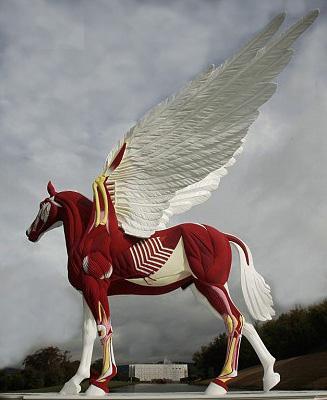Sotheby’s ‘BEYOND LIMITS’ Features New Works by Marc Quinn Takashi Murakami and Yayoi Kusama
The art auction house Sotheby’s is about to unveil its most ambitious exhibition for Chatsworth house to date. Beyond Limits is its annual selling exhibition of monumental sculpture, to be staged within the historic grounds of the ancestral home of the Dukes of Devonshire at Chatsworth from 16th September to 30th October 2011. This magnificent location provides a unique opportunity for the presentation and sale of monumental sculpture. The juxtaposition of works by artists as diverse as René Magritte and Takashi Murakami makes this year’s show an exciting destination exhibition for collectors and visitors alike. In addition to works by Lynn Chadwick, Barry Flanagan and William Turnbull, Beyond Limits will showcase a dramatic new work by Damien Hirst and a series of sculptures created specifically for exhibition at Chatsworth by a range of contemporary artists.
Alexander Platon, Sotheby’s Senior Director and Head of Private Sales, Europe, said: “Visitors to Beyond Limits 2011 will find this the most diverse and dynamic of our selling exhibitions at Chatsworth to date. Sotheby’s is delighted to offer a spectacular collection of monumental sculptures. This is a truly international show, featuring artists from as far afield as Spain, Taiwan, Korea, Argentina and Lebanon. Many works are being shown at Chatsworth for the first time and visitors will have the chance to view Damien Hirst’s remarkable Legend as well as his Myth, ahead of a major retrospective of his work at Tate Modern next year.”
Damien Hirsthas chosen Beyond Limits 2011 as the venue to showcase his latest sculptural work. The artist has written that he believes that science and religion are the guiding lights for the human condition and they find eloquent expression in the majestic equine form of Legend (pictured page one). This monumental winged horse stands atop its plinth as an icon of Hirst’s new modern mythologizing art. Pegasus, embodying the freedom and nobility of nature, was the legendary beast that Bellerephon rode to defeat the Chimera. However Hirst’s Legend has come under the scrutiny of the vivisectionist. One flank has been surgically flayed, exposing its muscles and bare bones, showing the secrets of this mythological animal. An elegant counterpart is another sculpture by Hirst, Myth (2010), which depicts the fabled unicorn. Its shimmering white flank is also flayed to reveal the visceral musculature beneath.
Takashi Murakami’s unique Flower Matango from 2001 is a clear example of how Japan’s foremost contemporary artist merges contemporary culture with traditional Japanese training. At over 13 feet high, with its twisted vines and brightly coloured flowers with googly eyes emerging from a multi-coloured ball, the large-scale fiberglass, resin and iron sculpture makes an astonishing presence in its Chatsworth setting, appropriately sited in Flora’s Temple. The work, which took a year-and-a-half to complete, is a cerebral amalgam of high and low art that uses the artist’s iconic motif of eyes to create an effect that is at the same time joyful and unnerving to behold.
Marc Quinn’s monumental Burning Desire is based upon a naturalistic rendering of a Phalaenopsis orchid. The fine red petals defy the properties of the bronze medium in which they are cast, to appear almost weightless and ethereal. The work belongs to a series of sculptures and paintings through which Quinn explores the concept of ideal beauty achieved through genetic modification. Familiar though exotic, Burning Desire has been rendered uncanny by its immense scale, in which the flower takes on an almost ominous presence.
Regarded by some as the most important living female artist, Yayoi Kusamais represented by the new work Flowers That Bloom Tomorrow (pictured right). Kusama has revisited one of her most consistent figurative preoccupations, with a towering 9-feet-tall fiberglass flower. The artist’s latest works are amongst her most joyous creations and here the sculpture’s psychedelic colours provide a vibrant contrast with the natural landcape. Kusama’s work will feature in a major retrospective at Tate Modern next year.
Lebanese artist, architect and urban-painter Nadim Karamhas established himself through monumental sculpture with his trademark use of steel. Desert Sand (pictured left) is a striking example of one of Karam’s recurring signature figures; an animal shape in silhouette holding a totemic-looking pole. The work rises as a monolith, its rugged exterior of rusted steel poetically suggesting an aged presence that has undergone erosion and the slow passage of time.
The exhibition also features works by leading British sculptors Barry Flanagan, William Turnbull and Lynn Chadwick.
Large Blade Venus by William Turnbull(pictured left) is a work of harmonious concepts and cultivated beauty. Seeming to levitate upon its balance point, the sculpture’s elegance is drawn from the Japanese samurai sword or Chinese chopping knife. The work possesses a primordial quality, suggesting an idol or ancient Venus. Large Blade Venus was conceived in 1990 and distils the artist’s interest in the concept of metamorphosis. Other works by Turnbull are on view at Yorkshire Sculpture Park.
Lynn Chadwick’s enigmatic bronze Sitting Couple belongs to a series of his late monumental works on the theme. Executed between 1989 and 1990, the work is a continuation of his geometric figurative output of the 1970s, in which he explored themes of a universal personal and collective identity. The current work displays Chadwick’s increasing tendency towards naturalism. The angular bodies of the seated figures are softened by the cloaks that are draped around their frames, giving the figures a more tender appearance.
Beyond Limits, September 16th – October 30th 2011

